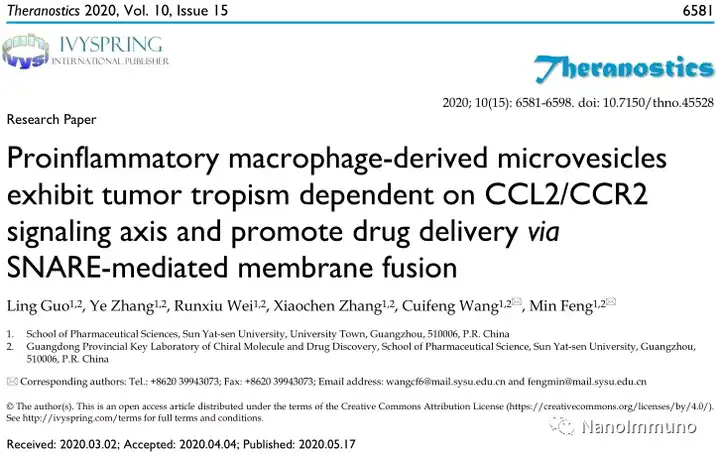Macrophage microvesicles rely on the CCL2/CCR2 signal axis to target tumors and SNARE-based membrane fusion to promote drug delivery
QQ Academic Group: 1092348845
Detailed

Extracellular Vesicles (Extracellular Vesicles, EVs) are vesicle-like bodies with a double-layer membrane structure that fall off the cell membrane or are secreted by the cell, with diameters ranging from 40nm to 1000nm. Extracellular vesicles are mainly composed of Apoptosis Body (APB), Microvesicles (MIV) and Exosomes (Exo). Exosomes-based chemotherapeutic drug delivery systems have been extensively studied, but the therapeutic potential of other subtypes of extracellular vesicles, especially microvesicles, seems to be ignored.
On May 17, Theranostics published online the latest achievement of the team of Professor Feng Min from the School of Pharmacy of Sun Yat-sen University "Proinflammatory macrophage-derived microvesicles exhibit tumor tropism dependent on CCL2/CCR2 signaling axis and promote drug delivery via SNARE-mediated membrane fusion". The author used differential ultracentrifugation to separate extracellular vesicle subpopulations derived from pro-inflammatory macrophages, including apoptotic bodies, microvesicles and exosomes, and further analyzed them by comparing proteomics and lipids.
On May 17, Theranostics published online the latest achievement of the team of Professor Feng Min from the School of Pharmacy of Sun Yat-sen University "Proinflammatory macrophage-derived microvesicles exhibit tumor tropism dependent on CCL2/CCR2 signaling axis and promote drug delivery via SNARE-mediated membrane fusion". The author used differential ultracentrifugation to separate extracellular vesicle subpopulations derived from pro-inflammatory macrophages, including apoptotic bodies, microvesicles and exosomes, and further analyzed them by comparing proteomics and lipids.
The results show that:
1. According to the biogenesis pathway of extracellular vesicles, the ability of microvesicles to obtain tumor targeting may come from the cell membrane rich in CC chemokine receptor type 2 (CCR2), which also Drives the recruitment of donor cells to tumor inflammation sites.
2. Microvesicles use Soluble NSF Attachment protein Receptor (SNARE)-mediated membrane fusion to directly release doxorubicin to the nucleus and bypass endocytosis degradation.
3. Compared with other subtypes of extracellular vesicles, microvesicles containing doxorubicin have significant advantages in chemotherapy results, including improving the survival rate of metastatic ovarian cancer. Therefore, microvesicles are an effective tumor-targeting drug carrier that replaces liposomes.
1. According to the biogenesis pathway of extracellular vesicles, the ability of microvesicles to obtain tumor targeting may come from the cell membrane rich in CC chemokine receptor type 2 (CCR2), which also Drives the recruitment of donor cells to tumor inflammation sites.
2. Microvesicles use Soluble NSF Attachment protein Receptor (SNARE)-mediated membrane fusion to directly release doxorubicin to the nucleus and bypass endocytosis degradation.
3. Compared with other subtypes of extracellular vesicles, microvesicles containing doxorubicin have significant advantages in chemotherapy results, including improving the survival rate of metastatic ovarian cancer. Therefore, microvesicles are an effective tumor-targeting drug carrier that replaces liposomes.
This information is sourced from the Internet for academic exchanges. If there is any infringement, please contact us to delete it immediately
- Previous: Harbin Institute of Te
- Next: A Rising 2D Star: Nove


 Academic Frontier
Academic Frontier